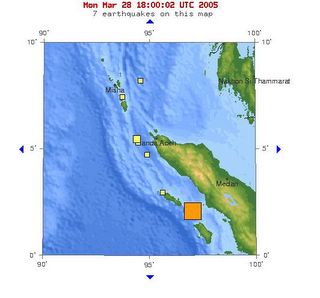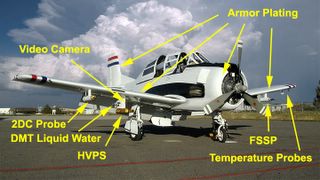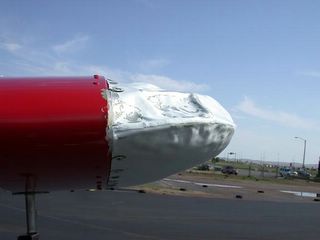Tuesday, March 29, 2005
You're hired!
The stronger the field of applicants, the more trivial the eventual selection criteria.
It's comforting to think that I might not have been selected for past jobs because of a fat neck. Or was it a big nose? Or was it an errant crumb? Or, or, or...
Or am I fooling myself that the field for my present position was strong? After all, they did take many, many months to reply... aiee, it's enough to drive one batty.
Monday, March 28, 2005
Auwe, another great Temblor:
The quake struck at about 11:10 PM local (11:10 AM EST), and was about one fiftieth as strong as the December 26 event. The hypocentre was about 30 km (+/- 6.1 km) deep, and was followed by a Mw 6.0 aftershock within about 30 minutes, offset to the South-East. It is not known at present whether these events produced tsunamis, but the rapid Moment Tensor Solution for this event shows an almost vertical motion for the event.

Another Indonesian earthquake today...

Friday, March 25, 2005
Spongebob's neighbourhood:
Here's Squidward's cousin, Octopeter marginatus, hoofing it (suckering?) across the Indonesian seafloor.
And Octopaul aculaeatus, looking a little frazzled, wanders away from the party...
(videos require the RealPlayer plug-in)
OK, ok, here's the whole story...grab onto it with all your arms & legs.
Wednesday, March 09, 2005
Why for you bury me in the cold, cold ground?
An article in Science (Vol 307, Issue 5712, 1035, 18 February 2005, summary) recently drew my attention to something that has bothered me for years.
For some reason, probably to do with the context in which I learned the word, a disease has always seemed to me to be something that was communicable, or that at least had some kind of vector. So things like leprosy, measles, malaria, influenza were diseases, while things like cancer, diabetes, Krohn's etc. were not. I would have called these latter things 'conditions.'
I now know this is not how they are defined medically, and that there is probably medical or epidemiological terminology to describe exactly the kind of separation I describe above, and that I still feel echoes of today when I hear the word 'disease' used to describe things that cannot be transmitted from one individual to another.
...or am I sure? The Science article describes a facial cancer that has been observed to be increasing in frequency among Tasmanian Devils. The disfiguring facial cancer eventually grows so large that it interferes with the creature's feeding, and they starve to death. The point in the article that stunned me was that this cancer seems to be spreading because the Tasmanian Devils are in fact spreading cancerous cells to each other as a consequence of the vicious fights they normally enage in, including biting each other's mouths. In other words, this is a cancer that is a communicable disease. Evidently these cancer cells can get around the self/non-self signals that are the basis for most immune systems. This is a cell that is not exactly some other form of life, but a mutated version of self.
I think this is more evidence that Nature loves these grey areas, and always holds a surprise, like a sort of fractal.
Tuesday, March 08, 2005
Farewell to a Trojan:
The ariplane was N10WX, a highly modified T-28 Trojan (WX is a common abbreviation for 'weather'). In the early 1960's the South Dakota School of Mines and Technology's Institute of Atmospheric Sciences began operating this bird as a scientific research platform, and until early 2004 flew it hundreds of times into storms that other pilots would take every possible precaution to avoid. Why choose a 1950's trainer in the 1960's, and operate it this long? Several reasons. First, it had a piston-driven prop rather than a turbofan - jet engines don't do so well in heavy hail, stalling and being unable to re-start. Second, it had a airframe strength/engine power combination that could support two heavy items: armor plating and a thick coat of ice. Third, that airframe was designed to withstand a lot of punishment (think keeping student pilots safe...). And fourth, there were a lot of them available for a good price (over 2200 were built - the other choice was the Douglas Dauntless, but purchase cost and maintenance ruled it out).
Here's a picture of the T-28, with some of the features pointed out:

Armored T-28

Of course, there are many more instruments and hard points for mounting them than shown here. The 700 lbs of armor plating is on all the tops and leading edges of the wings and the rudder and the radial engine cowling, and of course the canopy is also armored - the original plexiglass 'bubble' would never survive!
Here's the kind of damage the hail does - this is a shot of the wing-tip, and you can clearly see the difference that the armor plating makes - the original aluminium wing covering is severely battered, while the armor does not show any damage.

T-28 wingtip

There are several other areas that are heavily armored - the air intakes for the carburetor and for the oil cooler.
Of course, anything that stuck out was either going to get hammered or struck by lightning. What would usually be somewhat delicate instruments on other aircraft had to be modified (I wonder what the Pitot looks like on this thing?). Here's a shot of a detector with a somewhat crumpled dome...

instrument

My first thought on seeing these pictures was that it must have been incredibly LOUD in the cockpit. Not only were you riding a 1425 hp Wright Cyclone at several hundred knots, but the noise from the hail must have beed absolutely deafening, mixed in with the occasional lightning strike (which resulted in pieces melting off the trailing edges of the prop and rudder!).
Now that it has been retired, the School of Mines is in contact with the Smithsonian and others to see if anyone is interested in exhibiting N10WX. And of course, the scientific community is looking for another platform that can take this kind of punishment and keep the pilot safe. The candidates so far: an Air Force A-10 Thunderbolt "Warthog" (but chances are not good for an A-10 being released, given the current operations needs for both active ariframes and spares...); or a Coast Guard HU-25 Falcon. Both of these of course are turbofans - it will be interesting to see how the replacement holds up over 50 years of service - if they even make it that long.
The long-time pilot for the T-28, Tom Warner, has a nice homepage for the airplane here (as well as having some great WX photos that deserve a look!).